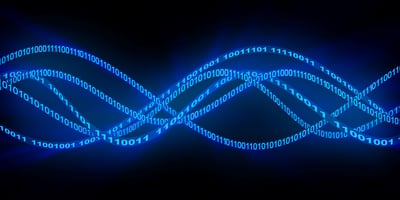Local oscillators (LO) are crucial components used in the upconversion and downconversion chains of...
What Adverse Effects Does Phase Noise Have on System Performance?
All signals experience random fluctuations in phase, a phenomenon referred to as phase noise. This blog post takes a look at real-world RF signal behavior from both a time and frequency perspective, and discusses the impact of phase noise on wireless systems.
RF Signal Behavior in the Time & Frequency Domains
In the frequency domain, phase noise manifests as sidebands on either side of the carrier signal. The frequency domain plots the power level of a signal’s individual frequency components over a specific range of frequencies. An ideal RF signal with no phase variations results in a single, constant frequency at a certain power level. Phase noise causes waveforms to deviate from complete phase stability, spreading energy into nearby bands.
In the time domain, which shows how a signal’s amplitude changes over time, phase noise will be shown as jitter with more jitter correlating to more phase noise.
The video below shows the difference between an ideal, distortion-free RF signal and a real-world signal with phase noise in both the time and frequency domains.
The Impact of Phase Noise & Common Measurement Methods
While there are various sources and components that can introduce phase noise, one common contributor is local oscillators (LOs). The LO component provides the ability to sum the IF signal to provide a more proper transmission frequency. An LO also allows for determining the differences in the receive signal from the initial LO and the intermediate frequency. Low phase noise LO performance is essential to ensure accurate frequency conversion. Oftentimes, testing an LO requires LO substitution, where a high-performance signal generator is used in its place.
Whether introduced by LOs or other means, phase noise can increase errors and degrade system performance, especially for radar and digital communications systems.
- Radar: Phase noise has several adverse effects on radar systems, one of which is masking Doppler-shifted return signals. Doppler radar receivers identify the frequency shift between the transmitted pulse and reflection from a moving target. In high phase noise conditions, radar systems can fail to detect returns that reflect only a small portion of the initial transmit signal.
- Digital Communications: Higher order modulation schemes offer faster data rates by increasing the number of signal states. As the number of signal states increases, the spacing between the decision boundaries continues to tighten. Symbols in close proximity to one another require ideal positioning so the receiver can identify them accurately. Phase noise can cause symbol misalignment, which can impact demodulation and increase symbol and bit errors.
There are two common phase noise measurement methods. One technique utilizes a spectrum analyzer while the other captures data with a phase noise analyzer. How do these measurements methods differ? When deciding between the two test options to measure the phase noise of your system or device, what limitations and advantages are important to consider?
Uncover the answers in "The Importance of Low Phase Noise and How to Measure It" white paper from Holzworth. The white paper also provides further detail on phase noise basics and its significant effects on the performance of radar and digital communications systems. Read it today by filling out the form below.



